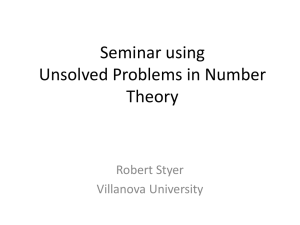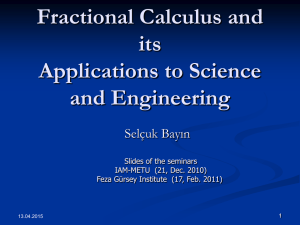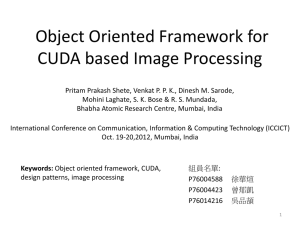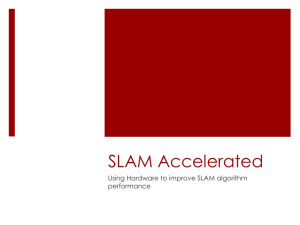Efficient Gaussian Packets representation and seismic imaging
advertisement
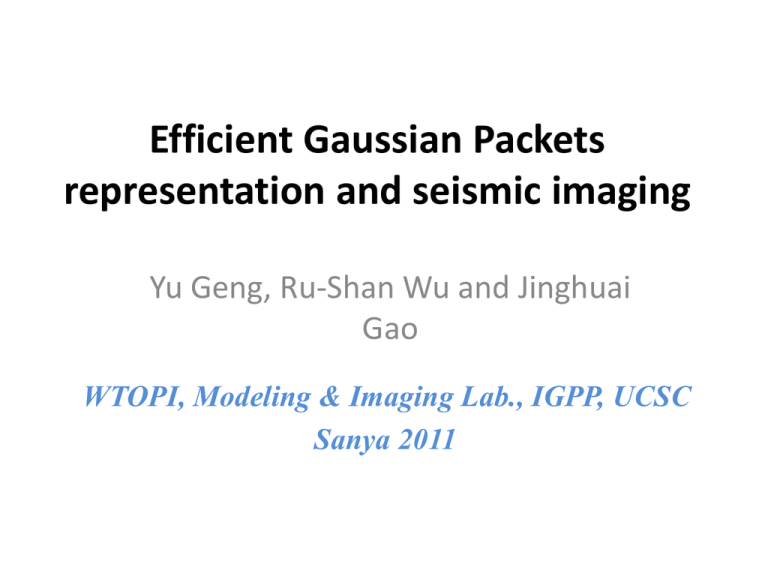
Efficient Gaussian Packets
representation and seismic imaging
Yu Geng, Ru-Shan Wu and Jinghuai
Gao
WTOPI, Modeling & Imaging Lab., IGPP, UCSC
Sanya 2011
OUTLINE
Introduction
Data representation using Gaussian Packets
Numerical examples
• Impulse response in different media
• Migration for a zero-offset data
Conclusions
INTRODUCTION
• Gaussian packets (GP), also called (space-time) Gaussian beams
(Raslton 1983) or quasiphotons (Babich and Ulin 1981), are highfrequency asymptotic space-time particle-like solutions of the wave
equation(Klimes 1989; Klimes 2004). They are also waves whose
envelops at a given time are nearly Gaussian functions.
• A Gaussian packet is concentrated to a real-valued space-time ray (in
a stationary medium, a Gaussian packet propagates along its-realvalued spatial central ray), as a Gaussian beam to a spatial ray.
• Decomposition of the data using optimized Gaussian Packets and
related migration in common-shot domain (Zacek 2004) are timeconsuming.
• We discussed an efficient way to use Gaussian Packets to data
decomposition and migration .
OUTLINE
Introduction
Data representation using Gaussian Packets
Numerical examples
• Impulse response in different media
• Migration for a zero-offset data
Conclusions
Gaussian Packet
• In the two-dimensional case, a Gaussian Packet can be written
as
gp
u ( x, z, t ) A exp(i )
is arbitrary positive parameter, and it can be understood as
the center frequency of the wave packet.
• Using Tayler expansion, the phase function can be further
expanded to its second order
px ( x xr ) pz ( z zr ) pt (t tr )
1
1
1
2
2
+ N xx ( x xr ) N zz ( z zr ) Ntt (t tr ) 2
2
2
2
+N xz ( x xr )( z zr ) N xt ( x xr )(t tr ) N zt ( z zr )(t tr )
Propagating a Gaussian Packet
• While propagating, a Gaussian Packet can nearly keep its
Gaussian shape in space in any given time.
To propagate a Gaussian Packet, we need to calculate
N , N , and A
Ni is the ray-theory slowness vector which can be determined by standard
ray tracing at the central point and Nt 1
N is complex-valued and determines the shape of the Gaussian Packet,
and its evolution along the spatial central ray is determined by quantities
calculated by dynamic ray tracing.
Amplitude can also be calculated during dynamic ray tracing.
A A
0
V0
V det(Q1 Q 2 M 0 )
Propagating a Gaussian Packet
• When t tr the Gaussian
Packet can be written as
usgp ( x, t ) A exp{i[ px ( x xr )
pz ( z zr )
1
N xx ( x xr ) 2
2
1
N zz ( z zr ) 2
2
N xz ( x xr )( z zr )]}
• Initial Parameters of Gaussian
Packet: Beam width and pulse
duration.
Profiles of Gaussian Packets
Propagating a Gaussian Packet
Snapshot at t 3 0.3s, 1.0s for a Gaussian Packet with different initial
beam curvature. White lines stand for corresponding central ray.
Snapshot for Gaussian Packets at t 3 0.7 s with different pulse duration
Data representation
• When z 0 the Gaussian Packet can be written as
usgp ( x, t ) A exp{i[ px ( x xr ) (t tr )
1
1
+ N xx ( x xr ) 2 Ntt (t tr ) 2 +N xt ( x xr )(t tr )]}
2
2
• Parameters of Gaussian Packet
xr
Space center location
tr
Time center location
Central frequency
px
Ray parameter
w0
Gaussian window width along space direction
Ntt0
Gaussian window width along time direction
Data representation
• The inner product between data and Gaussian Packet
can directly provides us the information of the local
slope at certain central frequency in the local time
and space area.
C pgpx , ,tr , xr u ( x, t ), usgp ( x, t )
• Cross term between time and space
usgp ( x, t ) A exp{i[ px ( x xr ) (t tr )
1
1
2
+ N xx ( x xr ) Ntt (t tr ) 2 +N xt ( x xr )(t tr )]}
2
2
Data representation
• Because of the cross
term between time and
space , decomposition of
the data into optimized
Gaussian Packets
becomes intricate.
sin
N xt
N tt px N tt0
V
0o
79o
Data representation
• It is obvious that when N xt is small enough, the cross
term Nxt ( x xr )(t tr ) can be ignored. Thus, the Gaussian
Packets are reduced into tensor product of two
Gabor function.
• To fully cover the phase space, the time and
frequency interval should satisfy
tr 2
• The space and ray parameter interval should satisfy
xr p 2 / r
Data representation
• When the beam width is given as (Hill,1990)
w0 2Va r and time duration as1 r Ntt0
the intervals can be written as
2
tr
p
x
2
w
r
0
0
2tr
r Ntt
4w0r
• The field contributed by Gaussian Packets at the
point (x, z) and time t
u( x, z, t )
px , ,tr , xr
C pgpx , ,tr , xr usgp ( x, z, t tr )
OUTLINE
Introduction
Data representation using Gaussian Packets
Numerical examples
• Impulse response in different media
• Migration for a zero-offset data
Conclusions
Numerical Examples
• Impulse response in different media
• A ricker wavelet with dominant frequency 15Hz and time
delay 0.3s as the source time function
Impulse response (LCB method)
impulse responses in a constant velocity media v=2km/s
with at time 0.8s
Impulse response (GP method)
N 3i
0
tt
Impulse response (GP method)
N 10i
0
tt
Impulse response (GP method)
N 20i
0
tt
Impulse response (GP method)
N 50i
0
tt
Impulse response (comparison)
Different GP
One-way
method
Ntt0 20i
GP compared with One-way method
Impulse response (LCB method)
The impulse responses with in a vertically linearly varying velocity media,
minimum velocity 2km/s , and linear varying parameter dv/dz=0.5s-1 ,
t=0.5s
Impulse response (GP method)
Ntt0 20i
t=0.3s
Impulse response (GP method)
Ntt0 20i
t=0.5s
Impulse response (GP method)
Ntt0 20i
t=0.8s
Impulse response (GP method)
Minimum velocity 2km/s , and linear varying parameter dv/dx=0.5s-1 ,
dv/dz=0.5s-1, t=0.1s
Impulse response (GP method)
Minimum velocity 2km/s , and linear varying parameter dv/dx=0.5s-1 ,
dv/dz=0.5s-1, t=0.3s
Impulse response (GP method)
Minimum velocity 2km/s , and linear varying parameter dv/dx=0.5s-1 ,
dv/dz=0.5s-1, t=0.5s
Impulse response (GP method)
Ntt0 20i
t=0.4s
Impulse response (GP method)
Ntt0 20i
t=0.5s
Impulse response (GP method)
Ntt0 20i
t=0.8s
Numerical Examples
• Migration for a zero-offset data
• The exploding reflector principle (Claerbout 1985)
states that the seismic image is equal to the
downward-continued, zero-offset data evaluated at
time zero, if the seismic velocities are halved.
u( x, z, t 0)
px , ,tr , xr
Cpgpx , ,tr , xr usgp ( x, z, t tr )
Migration for a zero-offset data
Migration for a zero-offset data
Migration for a zero-offset data
Conclusions
• we have introduced and tested an efficient Gaussian Packet
zero-offset migration method. The representation of the
data using Gaussian Packets directly provides the local time
slope and position information.
• We also have shown that with proper choice of time
duration parameter, only Gaussian Packets with few central
frequencies are needed to obtain propagated seismic data.
Imaging for a 4 layer velocity model zero-offset dataset
shows valid of the method.
• Although velocity has to be smoothed before ray tracing,
this method can be competitive as a preliminary imaging
method, and the localized time property is suitable for
target-oriented imaging.
Acknowledgments
• The author would like to thank Prof. Ludek
Klimes, Yingcai Zheng and Yaofeng He for
useful information and fruitful discussion. This
work is supported by WTOPI (Wavelet
Transform On Propagation and Imaging for
seismic exploration) Project at University of
California, Santa Cruz.

